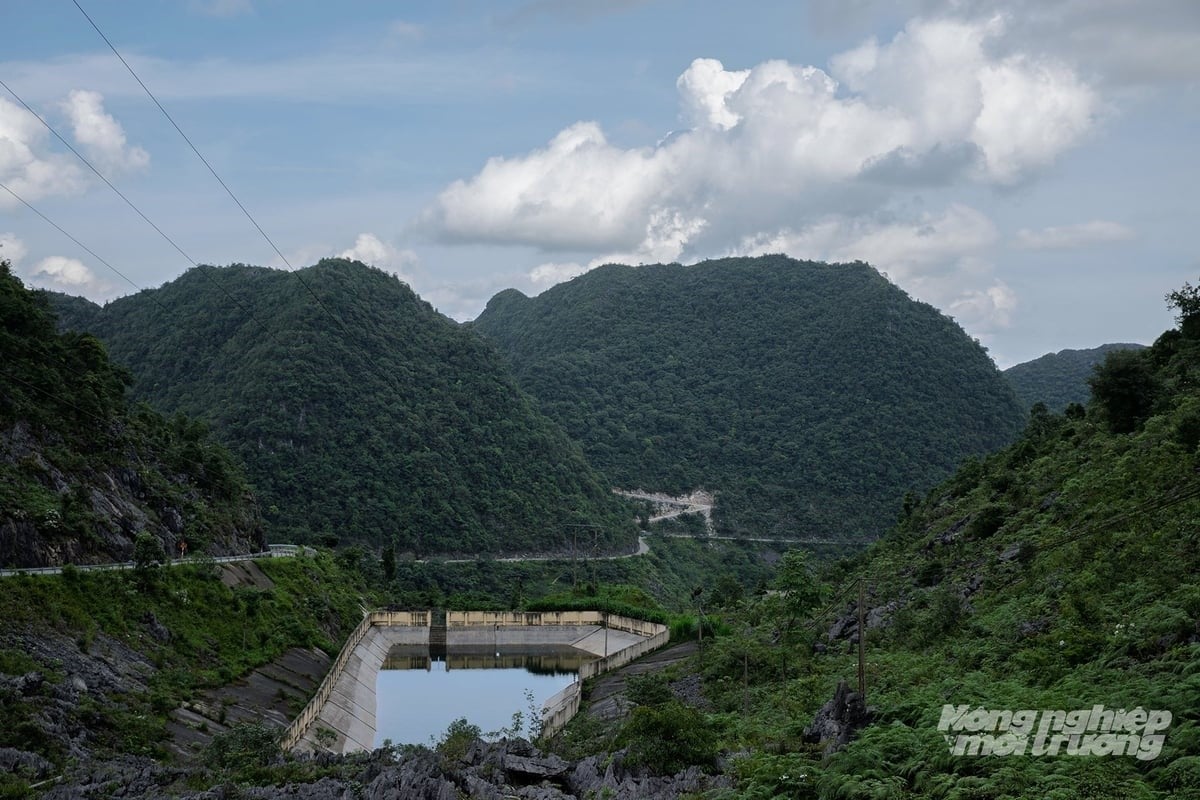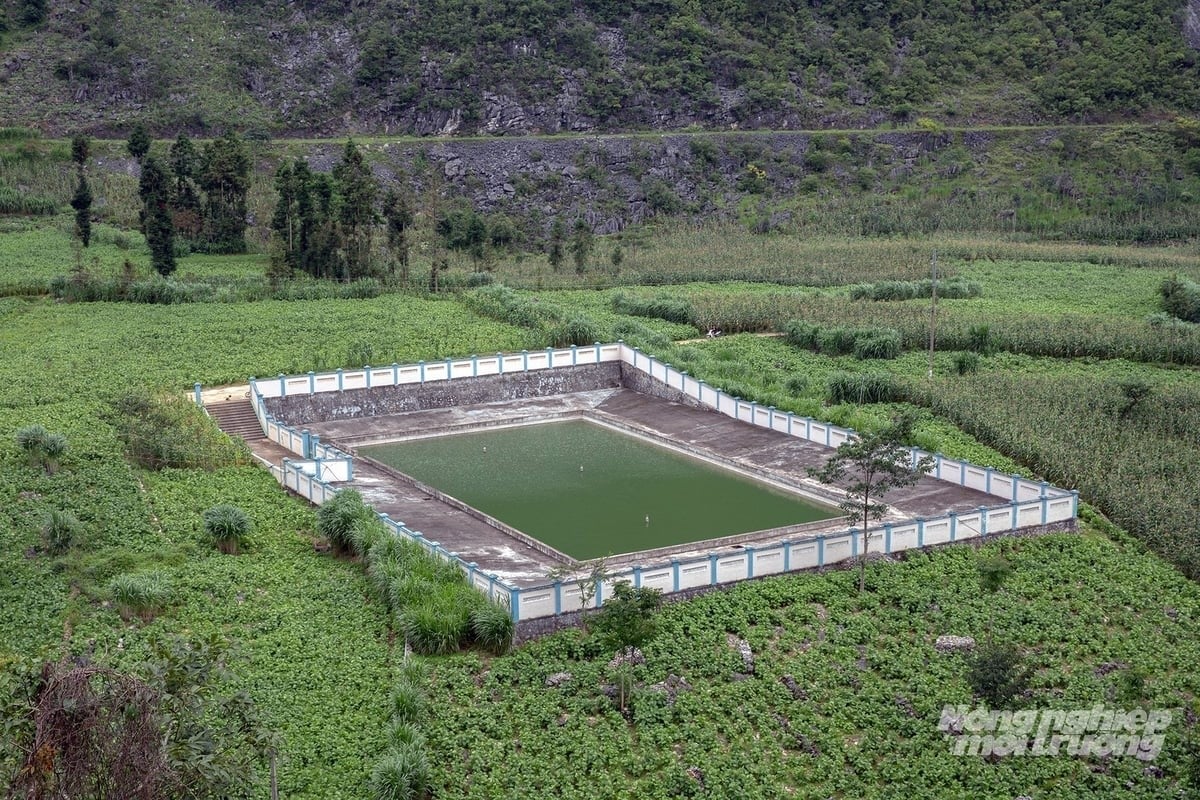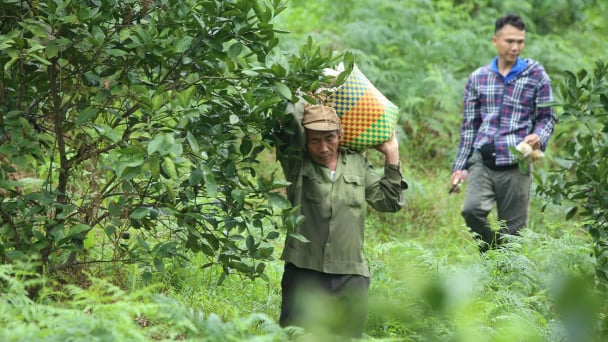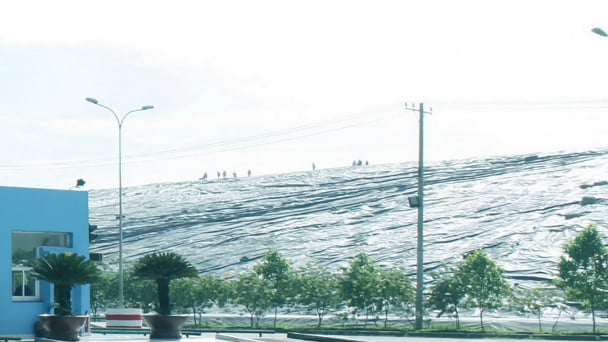August 8, 2025 | 14:51 GMT +7
August 8, 2025 | 14:51 GMT +7
Hotline: 0913.378.918
August 8, 2025 | 14:51 GMT +7
Hotline: 0913.378.918
20 years have passed since the first two pilot hanging reservoirs were constructed in Sa Phin and Ta Lung communes. Today, hundreds of such reservoirs have now been completed and put into use across the highland villages of Ha Giang. And more are expected to be built in remote and dry areas to supply water.
Launched in 2007, the "Water Reservoirs for Four Northern Rocky Highland Districts" project has so far resulted in the construction of 121 hanging reservoirs, with a total storage capacity of 554,643 m³. With a total investment of VND 1,370 trillion, the project has provided domestic water for over 100,000 people.
This figure represents over 500,000 m³ of rainwater that is now being retained and preserved, rather than being lost to evaporation, seepage, or uncontrolled waste.

A hanging reservoir was built on the rocky plateau in 2014. Photo: Kien Trung.
The practicality of hanging reservoirs in daily life is so evident that not only villages on the rocky plateau but also those in the western mountainous districts, such as Hoang Su Phi and Xin Man, have submitted petitions to the provincial authorities requesting investment in water reservoirs.
In June 2019, the People's Council of the former Ha Giang Province forwarded voters' proposals to the Provincial People's Committee. Of the nine issues raised in the agricultural, forestry, and rural sectors, four were related to hanging reservoirs.
Specifically, residents of Ha De hamlet suggested the province allocate funding for the construction of a new hanging reservoir and the repair of the existing Xin Cai reservoir to provide domestic water for the people of Lung Van Chai hamlet (Dong Van district) and Xin Cai commune (Meo Vac district). They also requested the construction of two new reservoirs to supply domestic water for Lung Chin, Co Sung, Lung Lan, Tu Lung Tren, Tra Man, and Lung Linh villages in drought-stricken Son Vi commune, where water shortages persist annually from September through January. Other proposals included building a hanging reservoir for Po Lo hamlet; constructing a water supply system and pipeline from Lan Xi hamlet to Chang Phung An hamlet in Pho Cao; and building the Ta Lu Than hanging reservoir on Pa Vay Su land in Xin Man, which was surveyed in 2016 but has yet to see construction.
In response to these legitimate petitions, the Ha Giang provincial government at the time acknowledged that, due to constraints in the province’s 2016–2020 medium-term budget that had to prioritize settling outstanding debts, funding for new hanging reservoir projects had to be temporarily suspended. Nevertheless, the province pledged to allocate resources to carry out this effective, practical, and deeply humanitarian initiative, including calling on organizations, individuals, and benefactors to contribute financial support for residents in remote, highland areas facing extreme hardship. Meanwhile, on the rocky plateau, hardship and rugged terrain is everywhere, and so is the shortage of water.

A hanging reservoir on the road to the Vuong Family Mansion relic site. Photo: Kien Trung.

Precious bags of freshwater on the rocky plateau. Photo: K. Trung.
After valuable lessons had been drawn from the construction and operation of the Sa Phin reservoir (with a capacity of 3,000 m³ and construction commenced in May 2002) and, most importantly, after the State allocated funding for implementation, the hanging reservoirs built in later years were expanded significantly in both scale and capacity. As a result, they could supply clean domestic water to a larger population and extend to nearby villages.
Typically, newly built hanging reservoirs have a capacity ranging from 2,500 to 5,000 m³, supplying water to groups of 150–300 households. The walls and base of the reservoirs are mainly made of concrete or reinforced concrete. Auxiliary facilities include water collection systems that channel water via pipes from small natural springs or from the reservoir’s water catchment terrace and water supply systems that convey water from the reservoir to filtration tanks and onward to storage tanks located near residential areas.
In 2022, once again, Ha Giang conducted a comprehensive review and assessment of the operational efficiency of all existing hanging reservoirs in the province. At the time, Mr. Hoang Hai Ly, Director of the Ha Giang Department of Agriculture and Rural Development, stated that the reservoirs were being effectively managed, operated, and utilized, performing their dual role of storing water during the rainy season and fundamentally addressing water shortages in the dry season (lasting 4-6 months each year) for about 33% of the population in the four northern rocky highland districts.

Over the past two decades, 121 hanging reservoirs have been built, providing domestic water for more than 100,000 people and reducing the rate of water shortages on the rocky plateau by over 30%. Photo: K. Trung.
According to Mr. Ly, selecting locations for these projects has been relatively convenient, with uncomplicated technical solutions and scale kept and short completion time thanks to the reservoirs’ modest size (small capacity and small water supply range). Most reservoirs leverage water from natural springs (small water sources), while a few collect rainwater from catchment terraces. Moreover, the investment required for each reservoir is not large, aligning with the province’s constrained budget over the past years.
Ensuring domestic water has helped residents stabilize their lives and concentrate resources on household economic development, thereby contributing significantly to hunger eradication and poverty reduction in remote areas. It has also improved education levels and created favorable conditions for ethnic communities to escape poverty and develop tourism in the Dong Van Karst Plateau. In addition, some reservoirs have become tourist highlights, serving as scenic spots for tourists to take photos.
However, Mr. Hoang Hai Ly acknowledged that these hanging reservoirs are small-scale works with limited storage capacity, holding only modest volumes of water. They currently address dry-season shortages only for small, concentrated residential areas and commune- or village-level administrative offices, without meeting the water demands of other sectors.
Additionally, water quality is not yet fully guaranteed, particularly in the long term, due to the impacts of climate change. Hanging reservoirs have yet to address the risk of declining water quality and quantity and have not resolved the issue of utilizing and regulating water resources to ensure a sustainable supply.
The northernmost province's agriculture sector is now considering the construction of large, multipurpose reservoirs. Based on an assessment and analysis of the advantages and disadvantages of investing in hanging reservoirs versus large multi-purpose reservoirs, the department will seek the Provincial People’s Committee’s approval to conduct feasibility studies for building multi-purpose reservoirs across the province. Priority will be given to four northern highland districts (Quan Ba, Yen Minh, Dong Van, and Meo Vac) and two western districts (Xin Man and Hoang Su Phi) of the former Ha Giang province.
“The appraisal process for investment proposals and technical designs of hanging reservoirs must be considered alongside plans for large multi-purpose reservoirs before approval. If conditions permit, priority should be given to the construction of multi-purpose reservoirs to minimize overlapping and duplicated investments, thereby avoiding waste of investment capital,” Mr. Hoang Hai Ly emphasized.
Translated by Thu Huyen
![Sky-high reservoirs on rocky plateau: [4] Heart of Sa Phin hamlet](https://t.ex-cdn.com/nongnghiepmoitruong.vn/608w/files/huyenvt (e)/2025/08/07/3148-3-181558_541.jpg)
(VAN) Sa Phin hanging reservoir, the first irrigation structure on the Dong Van plateau, is heart-shaped. Within that heart lies water, considering the source of life.
![Sky-high reservoirs on rocky plateau: [3] A catalyst for ecotourism development](https://t.ex-cdn.com/nongnghiepmoitruong.vn/608w/files/huyenvt (e)/2025/08/07/3722-3-101858_203.jpg)
(VAN) More than just quenching the thirst of dry areas on the rocky plateau, hanging reservoirs are now contributing to the development of ecotourism.
![Sky-high reservoirs on rocky plateau: [2] Quenching the thirst in Can Chu Phin](https://t.ex-cdn.com/nongnghiepmoitruong.vn/608w/files/huyenvt (e)/2025/08/06/4406-4-214016_602.jpg)
(VAN) For nearly two decades, villages on the rocky plateau have had their thirst eased thanks to hanging reservoirs and solid water storage tanks built under poverty reduction projects.

(VAN) Ho Chi Minh City and Hyogo Prefecture strengthen cooperation on green transition, creating opportunities for clean agriculture, environmental technology, and climate change adaptation training.

(VAN) With abundant water resources, North Central Vietnam is nurturing pineapple, tea, and citrus trees into sustainable brands, closely tied to resource management and a vision for development.

(VAN) Ho Chi Minh City is implementing a comprehensive set of measures to ensure that over 90% of municipal solid waste is treated using advanced, modern technologies by 2030.